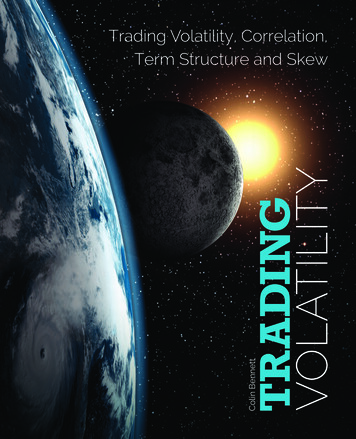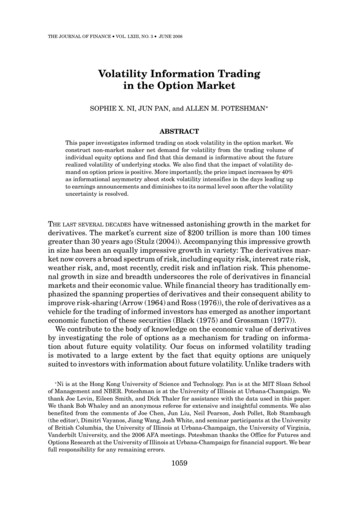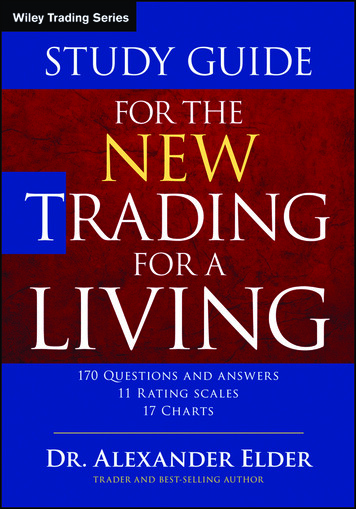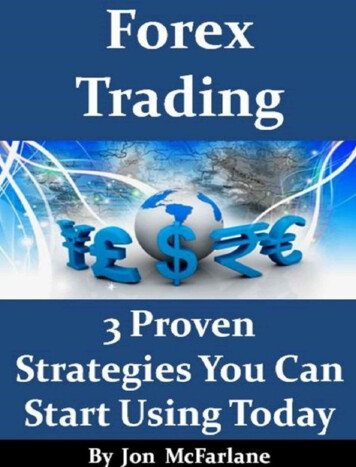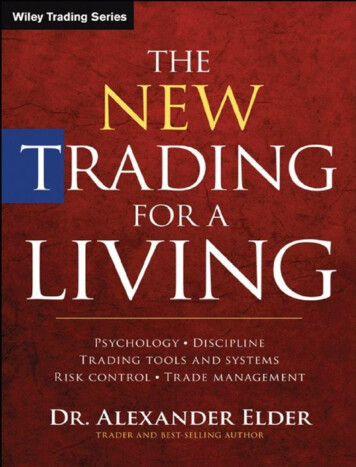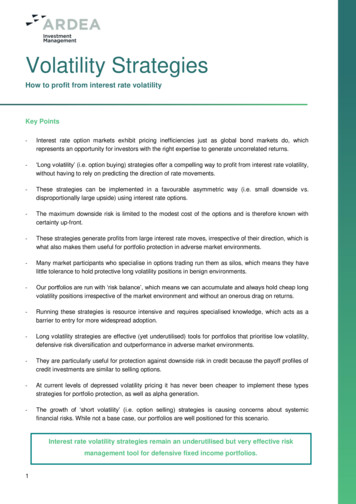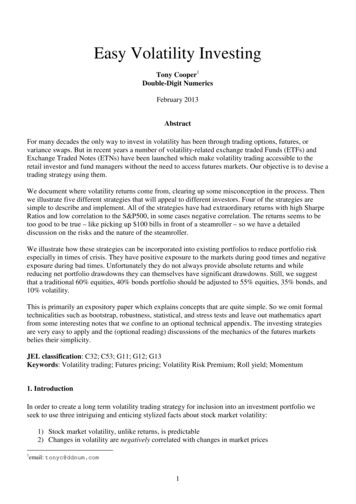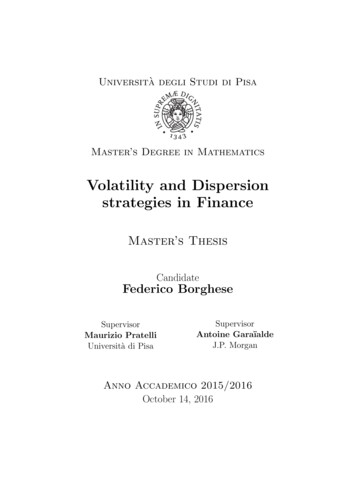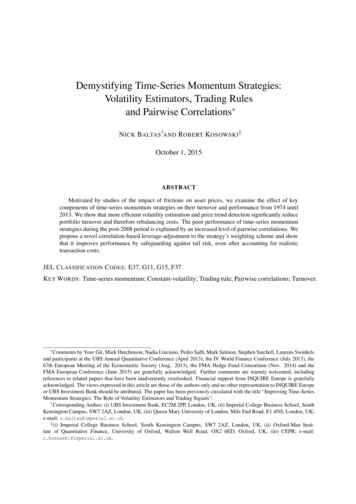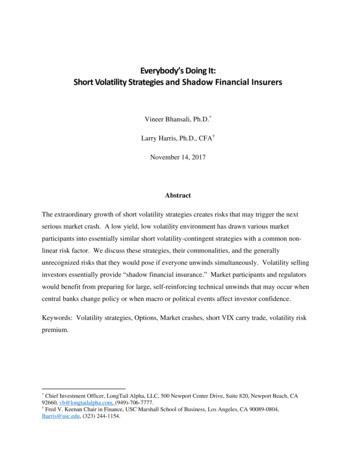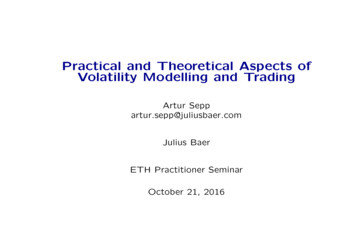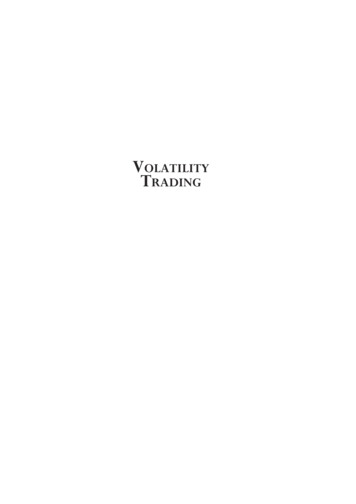
Transcription
VOLATILITYTRADING
Founded in 1807, John Wiley & Sons is the oldest independent publishingcompany in the United States. With offices in North America, Europe,Australia, and Asia, Wiley is globally committed to developing and marketingprint and electronic products and services for our customers’ professionaland personal knowledge and understanding.The Wiley Trading series features books by traders who have survivedthe market’s ever changing temperament and have prospered—some byreinventing systems, others by getting back to basics. Whether a novicetrader, professional, or somewhere in-between, these books will providethe advice and strategies needed to prosper today and well into the future.For a list of available titles, visit our website at www.WileyFinance.com.
VOLATILITYTRADINGSECOND EDITIONEuan Sinclair
Copyright 2013 by Euan Sinclair. All rights reserved.Published by John Wiley & Sons, Inc., Hoboken, New Jersey.First edition published by John Wiley & Sons, Inc. in 2008.Published simultaneously in Canada.No part of this publication may be reproduced, stored in a retrieval system, or transmitted in anyform or by any means, electronic, mechanical, photocopying, recording, scanning, or otherwise,except as permitted under Section 107 or 108 of the 1976 United States Copyright Act, withouteither the prior written permission of the Publisher, or authorization through payment of theappropriate per-copy fee to the Copyright Clearance Center, Inc., 222 Rosewood Drive, Danvers,MA 01923, (978) 750-8400, fax (978) 646-8600, or on the Web at www.copyright.com. Requeststo the Publisher for permission should be addressed to the Permissions Department, John Wiley &Sons, Inc., 111 River Street, Hoboken, NJ 07030, (201) 748-6011, fax (201) 748-6008, or onlineat http://www.wiley.com/go/permissions.Limit of Liability/Disclaimer of Warranty: While the publisher and author have used their bestefforts in preparing this book, they make no representations or warranties with respect to theaccuracy or completeness of the contents of this book and specifically disclaim any implied warrantiesof merchantability or fitness for a particular purpose. No warranty may be created or extended bysales representatives or written sales materials. The advice and strategies contained herein may notbe suitable for your situation. You should consult with a professional where appropriate. Neitherthe publisher nor author shall be liable for any loss of profit or any other commercial damages,including but not limited to special, incidental, consequential, or other damages.For general information on our other products and services or for technical support, please contactour Customer Care Department within the United States at (800) 762-2974, outside the UnitedStates at (317) 572-3993 or fax (317) 572-4002.Wiley publishes in a variety of print and electronic formats and by print-on-demand. Some materialincluded with standard print versions of this book may not be included in e-books or in print-ondemand. If this book refers to media such as a CD or DVD that is not included in the version youpurchased, you may download this material at http://booksupport.wiley.com. For moreinformation about Wiley products, visit www.wiley.com.Library of Congress Cataloging-in-Publication Data:Sinclair, Euan, 1969–Volatility trading / Euan Sinclair. — Second edition.pages cm. — (Wiley trading series)Includes bibliographical references and index.ISBN 978-1-118-34713-3 (cloth/website); ISBN 978-1-118-42044-7 (ebk);ISBN 978-1-118-57487-4 (ebk); ISBN 978-1-118-41672-3 (ebk)1. Options (Finance). 2. Hedging (Finance). 3. Futures. 4. Financial futures. I. Title.HG6024.A3S5623 2013332.64’5—dc232012047062Printed in the United States of America.10 9 8 7 6 5 4 3 2 1
To Ann—Sometimes a trader wins much more than he deserves.
CONTENTSAcknowledgmentsIntroduction to the Second EditionxixiiiOption PricingThe Black-Scholes-Merton ModelModeling AssumptionsConclusionSummary1171111CHAPTER 2Volatility MeasurementDefining and Measuring VolatilityDefinition of VolatilityAlternative Volatility EstimatorsUsing Higher-Frequency DataSummary131314202933CHAPTER 3Stylized Facts about Returnsand VolatilityDefinition of a Stylized FactVolatility Is Not ConstantCharacteristics of the Return DistributionVolume and VolatilityDistribution of VolatilitySummary35353640434546CHAPTER 1vii
CHAPTER 4CONTENTSviiiVolatility ForecastingAbsence of Transaction CostsPerfect Information FlowAgreement about the Price Implicationsof InformationMaximum Likelihood EstimationVolatility Forecasting UsingFundamental InformationThe Variance PremiumSummary495050606265CHAPTER 5Implied Volatility DynamicsVolatility Level DynamicsThe Smile and the UnderlyingSmile DynamicsTerm Structure DynamicsSummary677080829091CHAPTER 6HedgingAd Hoc Hedging MethodsUtility-Based MethodsEstimation of Transaction CostsAggregation of Options on Different UnderlyingsSummary939596109113115CHAPTER 7Distribution of Hedged Option PositionsDiscrete Hedging and Path DependencyVolatility DependencySummary117117123129CHAPTER 8Money ManagementAd Hoc Sizing SchemesThe Kelly CriterionTime for Kelly to DominateEffect of Parameter Mis-Estimation1311311331431445054
146148161CHAPTER 9Trade EvaluationGeneral Planning ProceduresRisk-Adjusted Performance MeasuresSetting GoalsPersistence of PerformanceRelative PersistenceSummary163164171178180180184CHAPTER 10PsychologySelf-Attribution BiasOverconfidenceThe Availability HeuristicShort-Term ThinkingLoss AversionConservatism and RepresentativenessConfirmation BiasHindsight BiasAnchoring and AdjustmentThe Narrative FallacyProspect 12CHAPTER 11Generating Returns through VolatilityThe Variance PremiumReasons for the Variance PremiumSummary213214220222CHAPTER 12The VIXThe VIX IndexVIX FuturesVolatility ETNs223224225227ixCONTENTSWhat is Bankroll?Alternatives to KellySummary
CONTENTSxOther VIX TradesSummary229230CHAPTER 13Leveraged ETFsLeveraged ETFs as a Trade-Sizing ProblemA Long-Short Trading StrategyOptions on Leveraged ETFsSummary231234234235237CHAPTER 14Life Cycle of a TradePretrade AnalysisPosttrade AnalysisSummary239239245247CHAPTER 15ConclusionSummary249252ResourcesDirectly Applicable BooksThought-Provoking BooksUseful Websites253253256257ReferencesAbout the WebsiteAbout the AuthorIndex261273279281
ACKNOWLEDGMENTSAproject like this invariably could not be accomplished without manyforms of help and support from many people. Although they had nodirect involvement in the writing, I need to first thank my parents, whomade me appreciate education and taught me that boredom is a mortal sin.I must also thank my wife for her patience as I wrote this instead of doingvarious chores around the house.For more direct professional help, the regulars at www.nuclearphynance.com have been very generous with their time and knowledge. Their helpwith finding various research papers has also been invaluable.Finally, Chris Merrill, Jitu Patel, and Erin Callahan gave direct help withproofreading and technical assistance. Thank you.xi
INTRODUCTION TO THE SECOND EDITIONSince the first edition of Volatility Trading was published, the volatilitymarkets have changed. One might think that the big change was theexceptionally volatile period at the end of 2008, followed by the long, slowdecline of volatility since then. Although this has certainly made tradingchallenging, markets have behaved like this before and no doubt will again.This kind of change is always happening. More interesting has been thetrend for exchanges to list volatility-dependent products (futures, exchangetraded funds [ETFs], and exchange-traded notes [ETNs]). This gives us newways to make volatility trades and relative value bets. In this edition, we lookat the Volatility Index (VIX) futures and ETNs, as well as leveraged ETFs.Another major change has been the increasing effects of high frequencytrading. Traders who are aggressively market-making equity options, tryingto be on every bid and offer, will have to take such algorithms into account.These strategies are not covered in this book. My focus is on positionaltrading of volatility, and these trades generally have holding periods of daysto months. These timescales are far from high frequency. About This BookThe concepts behind this type of trading are largely unchanged, butmy emphasis has probably changed slightly. Although academics havecontinued to work on forecasting volatility, I think the improvements fromthe perspective of an option trader are now marginal. For example, theprofitability of equity volatility long short portfolios has declined significantlyxiii
INTRODUCTION TO THE SECOND EDITIONxivover the past five years. This would probably not be what I would choose tofocus on now. So although I have slightly expanded the section on volatilityforecasting, I think it is now more important than ever to look for situationswhere the odds are in our favor whether we can accurately measure andforecast volatility. To this end, I have added chapters on stylized facts ofmarkets and the variance premium.I have also expanded the chapter on psychology. The usefulness ofbehavioral psychology to traders is still a matter of debate. Tradersthemselves seem to be greatly polarized, either being true believers orcompletely dismissive. I make no apologies for being a believer. I know thatstudying this has helped me.I see trading as a process and I’ve tried to write this book to be consistentwith this view. It was intended to be read in the order presented. However,most chapters are self-contained and there is probably no great harm injumping around from section to section. An exceptionally impatient readercould even gain much of the benefit of the material by just looking at thesummary at the end of each chapter. Some more tangential material, mainlymathematical in nature, has been relegated to sidebars. These can probablybe skipped entirely without losing continuity.This book is about trading volatility. More specifically, it is about usingoptions to make trades that are primarily dependent on the range of theunderlying instrument rather than its direction.Before discussing technicalities, I give a brief description of my tradingphilosophy. In trading, as in most things, it is necessary to have generalguiding principles in order to succeed. Not everyone need agree on thespecific philosophy, but its existence is essential. For example, it is possibleto be a successful stock market investor by focusing on value-style investing,buying stocks with low price-to-earnings or price-to-book ratios. It is alsopossible to be a successful growth investor, buying stocks in companies thathave rapidly expanding earnings. It is not possible to succeed consistently byrandomly acquiring stocks and hoping that things just work out.I am a trader. I am not a mathematician, financial engineer, or philosopher.My success is measured in profits. The tools I use and develop need onlybe useful. They need not be consistent, provable, profound, or even true.My approach to trading is mathematical, but I am no more interested inmathematics than a mechanic is interested in his tools. However, a certainlevel of knowledge, familiarity, and even respect is needed to get the mostout of these tools.There is no attempt here to give a list of trading rules. Sorry, but marketsconstantly evolve and rules rapidly become obsolete. What do not become
xvINTRODUCTION TO THE SECOND EDITIONobsolete are general principles. These are what I attempt to provide. Thisapproach isn’t as easy to digest as a list of magic rules, but I do not claimmarkets are easy to beat, either. The specifics of any trade are alwaysdifferent, but general guidelines can always point us somewhat in the rightdirection. Some latitude in strategy is desirable and adaptability is essential,but there are also a number of things that have to be firmly in place inorder to succeed. Picasso and Braque may have broken many rules, but theycould certainly paint very well technically before they did so. Similarly,before you start adjusting strategies, make sure you have a good grasp of thefundamental aspects on which all trades need to be based: edge, variance,and appropriate size.Certain old-school traders have used arguments like: ‘‘Trading is abouthumans. Your models can’t capture the human element.’’ This generallyseems to be said in a defensive manner. Maybe their models can’t capturethe human element, but ours will capture at least part of it. Most ofthe reluctance of such traders to embrace quantitative techniques can beattributed to defensiveness and aversion to change. It probably isn’t dueto any deep aversion to quantification. After all, in the same way thattraditional baseball people hate the new statistical analyses but are finewith batting average and earned run averages, many traditional optiontraders denigrate quantitative analysis while being perfectly happy with theBlack-Scholes-Merton paradigm and the concept of implied volatility. Theyare probably just unwilling to admit that they need to continue to learn andare worried that their skills are becoming obsolete. They should be. We allshould be. This is a continually evolving process.However, when successful traders say something like this, we need toconsider that they may be partly correct. Some traders do indeed havefinely honed intuition, generally called feel when applied to market sense.Intuition exists and can even be developed, but generally not quickly. Also,just because some traders have feel does not mean all, or even many, do.The approach we develop based on mathematics and measurement can besystematically learned. Given that it can be learned, what excuse is there notto learn it? Further, while a logic-based trader may never be able to developeffective intuition, an intuitive trader can always benefit from logic-basedreasoning.Although markets are designed and populated by human
Volatility trading/Euan Sinclair. — Second edition. pages cm. — (Wiley trading series) Includes bibliographical references andindex. ISBN 978-1-118-34713-3 (cloth/website); ISBN 978-1-118-42044-7 (ebk); ISBN 978-1-118-57487-4 (ebk); ISBN 978-1-118-41672-3 (ebk) 1. Options (Finance). 2. Hedging (Finance). 3. Futures. 4. Financialfutures. I. Title. HG6024.A3S5623 2013 332.64’5—dc23 .
